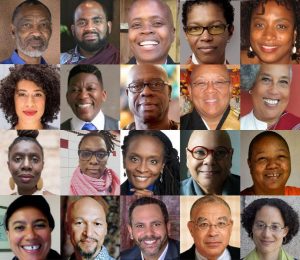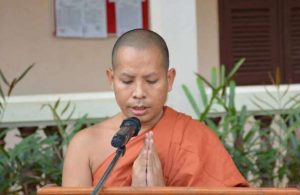Editor’s note: “Teachings of Amitabha Buddha” is an inspiring column about the vital spiritual matters of Pure Land Buddhism – from its history, philosophy, and practice to its scriptures and their exegesis and interpretation. The column is penned by Alan Kwan, the founding editor of Buddhistdoor.com.
In the Commentary on the Contemplation Sutra, Master Shandao opened the door to the Pure Land. Pure Land is based on the two teachings of two Buddhas. One is known as the Path of Importance expounded by Shakyamuni Buddha, and the other is the Path of Great Vow by Amitabha Buddha with his alternative intent.
What are the differences in practice between these two teachings in Pure Land Buddhism?
Purification of Mind by Self-Power
Shakyamuni Buddha teaches an ordinary being how to become a sage (free from rebirth within the Six Realms) through the practices of the Three Studies (precepts, meditation and wisdom) with one’s own effort (‘self-power’). By doing this, a being can eliminate the delusions and karmic obstructions, and realize the ultimate truth. Shakyamuni’s teaching is focused on enlightenment in the pursuit of wisdom, which is basically to purify the mind.
For Bodhisattva practices, the practitioner has to cultivate the Six Paramitas: generosity, virtue, forbearance, vigor, meditation and wisdom. He is also required to practice the four means of conversion (samgrahavastu), which are giving, comforting in speech, accompanying to work and sharing the benefits.
Shakyamuni’s teaching is characterized as ‘self-power’ because the merits and virtues are attained through the practices of the Three Studies with one’s own effort, as defined by Master Tanluan in his Commentary of Treatise on Rebirth. It is also known as a ‘teaching of causal ground’. The cultivation starts from the causal ground of an ordinary being and finishes at the reward ground of the sage, like a Bodhisattva, up to a Buddha.
Master Yinguang, a great Pure Land patriarch in the Qing Dynasty, called this kind of Bodhisattva teaching the ‘Common Path.’ The Arhat or Bodhisattva practice involves a great variety of meditative and non-meditative virtues with ‘self-power,’ which generates assorted and miscellaneous merits in different aspects of cultivation. It is necessary for a Bodhisattva, who sets forth his Bodhi Mind to pursue the Buddhist Way above and deliver all beings below, to be well-rounded in knowledge and ability. Only then can she deliver all kinds of sentient beings in different capacities and interests under various circumstances.
Nagarjuna Bodhisattva called this kind of practice the Difficult Path in the Chapter on Easy Path because it takes a long time and great effort, like walking step by step towards the destination.
With respect to all these characteristics of Shakyamuni Buddha’s teachings, letting go and dedication of the virtuous practices is necessary if the practitioner changes to the Pure Land teaching. This is because these virtues attained by the ‘self-power’ of an ordinary being in the Saha World are not ‘real’ or insubstantial; therefore they are incompatible with those in the Land of Bliss – a realm of unconditioned nirvana. As far as rebirth is concerned, these virtues are irrelevant, inapplicable and excluded. They should be dedicated and transferred to others in the Saha World before the practitioner is determined to be reborn in the Land of Bliss. For details, please refer to my article published at the beginning of September 2013.
Rebirth in the Pure Land by Other-Power
Amitabha Buddha’s teaching is called the ‘Particular Path’ if one possesses true faith and strong aspiration, and holds fast in Amitabha-recitation. One must do so for rebirth with the aid of Buddha’s compassionate power, said Master Yinguang. Thus, the practice in Amitabha’s teaching is merely Amitabha-recitation.
In the Commentary on the Contemplation Sutra, Master Shandao explained why evil beings can be salvaged and reborn in the Land of Bliss by simply reciting the Buddha’s name – “Namo Amituofo” – ten times. He said, “In the Contemplation Sutra here, one who recites the Buddha’s name ten times fulfils the qualification of ten aspirations and ten practices. Why does he fulfill? Namo means taking refuge, and also represents his mind of dedication and aspiration, and Amitabha is his practice. That is the reason why he must be reborn.”
‘Namo Amituofo’ represents the Three Sambharas, namely faith, aspiration and practice, which are essential to be reborn in the Pure Land according to the 18th vow made by Amitabha Buddha. The most evil person ever will be salvaged and welcomed by Amitabha Buddha if he only: dedicates or discards all his karmic practices; aspires wholeheartedly to be reborn in the Pure Land; and recites only ten times ‘Namo Amituofo’ just before he dies. Such is the incredible vow and compassionate power of Amitabha Buddha!
Nagarjuna Bodhisattva called this kind of practice the Easy Path in his writing, the Chapter on Easy Path because it takes less time and almost no effort, like sailing on a ship.
It is always difficult to be a master who voluntarily provides everything to serve his subordinates and followers. However, it is much easier if one comes over and gives allegiance to a master, and takes advantage of what he provides others. In Pure Land Buddhism, it is difficult for a being to become a Buddha, like Amitabha, to deliver sentient beings. However, it is much easier for a being to believe and accept Amitabha’s deliverance, so as to enjoy his bestowed merits and virtues, including rebirth in his Pure Land.
Once reborn in the Pure Land by ‘other-power,’ a practitioner can transcend his ordinary being to become a sage. As he dwells in the Pure Land, his mind and body grow pure too. With respect to the virtuous practices, he develops faith through Amitabha-recitation, instead of pursuing wisdom through meditative and non-meditative practices. Thus, Amitabha’s teaching is actually a teaching of achievement or reward ground initiated by the Buddha, while Shakyamuni’s teaching is a teaching of causal ground initiated by a practitioner himself. Both teachings are considered to be Mahayana Buddhism, but with a different approach and different perspective.
Oral invocation of Buddha’s name is the karma of assurance
In Pure Land Buddhism, there are four kinds of Buddha’s invocation: (1) invocation at the level of absolute reality, (2) meditative invocation, (3) invocation by visualization and (4) oral invocation of the Buddha’s name or name-recitation. However, Master Shandao followed the idea of Vasubandhu Bodhisattva and categorized the Buddha’s invocation into five in his Commentary of the Contemplation Sutra:
1. Exclusive reading – reading the three Pure Land Sutras only
2. Exclusive observance – observing Amitabha Buddha and his Land of Bliss only
3. Exclusive reverence – bowing to Amitabha Buddha only
4. Exclusive recitation – reciting Amitabha Buddha’s name only
5. Exclusive praising and making offerings – again to Amitabha Buddha only
According to Master Shandao, out of these five exclusive practices, exclusive recitation is the karma of assurance because it corresponds to the fundamental vow of Amitabha Buddha. Thus, it is noted that the unique characteristic of Buddha’s invocation in Pure Land is oral invocation. That means Amitabha-recitation is the one and only factor that is directly related to the rebirth of the practitioner.
It is because of the fundamental vow that the practitioner recites the Buddha’s name. He recites the Buddha’s name for the sake of being reborn in the Pure Land, nothing else. It is simple and straightforward, and is known as ‘the recitation of Amitabha’s name, according to his Fundamental Vow (the 18th vow).’ It is the essence and the main characteristic of the Path of Great Vow in Pure Land Buddhism.
Importance of Exclusivity in the Path of Great Vow
Exclusivity is always emphasized in the Path of Great Vow, which is contrary to the Path of Importance or other traditional Mahayana teachings. Master Shandao explained it with a simple verse, as follows:
The Land of Bliss is an unconditioned realm of nirvana;
It’s hard to be reborn there by practicing assorted virtues according to circumstances.
The Tathagata selects the key method –
He teaches us to recite Amitabha’s name with two-fold exclusivity.
The Saha Land is the conditioned realm of reincarnation, which is governed by the principle of cause and effect with all relative and differentiated phenomena. Thus, we have different kinds of beings, and assorted merits and virtues here. Moreover, they are all impermanent in nature, which is also contrary to the Land of Bliss.For beings who aspire to be reborn in the Land of Bliss, assorted merit and virtue in the Saha Land is not taken into account because the merits and virtues of Amitabha’s name is the one and only one cause of rebirth. That is why Master Tanluan said in his Commentary of Treatise on Rebirth, “All beings (to be reborn) due to one single cause – reciting Amitabha’s name, but no other practices”. The statement is commensurate with the equal, non-differentiated and unconditioned nature of the Land of Bliss.









